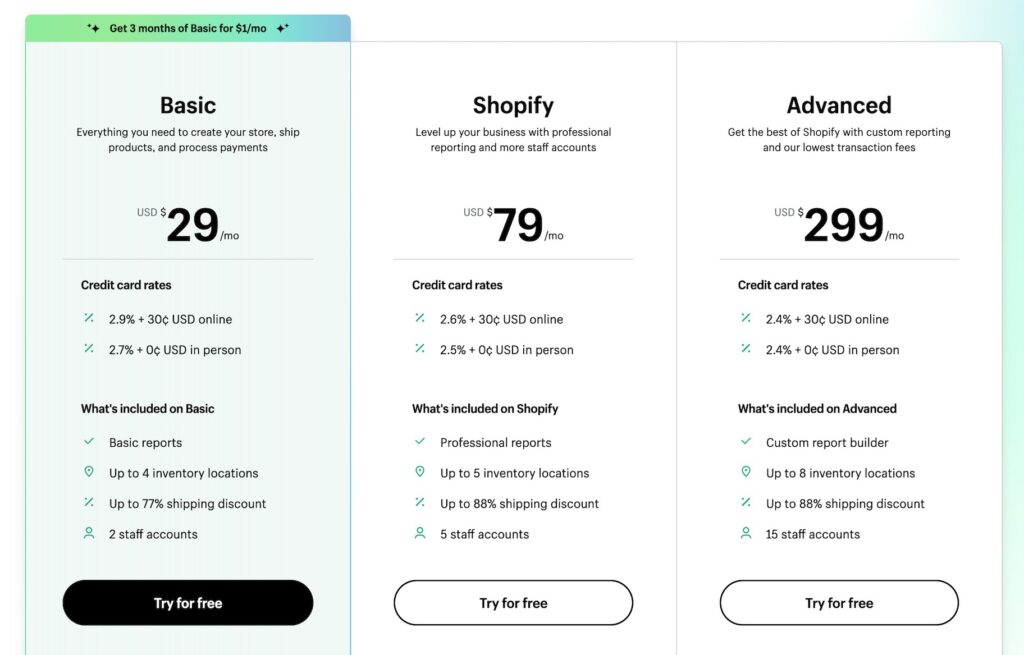- What is Shopify Payments?
- Shopify Payments Benefits Overview
- Are there any disadvantages of Shopify Payments?
- What fees does Shopify Payments charge?
- How is Shopify Payments different from PayPal?
- How is Shopify Payments different from Stripe?
- How do I set up Shopify Payments?
- How to connect Shopify Payments from Ukraine?
A new leader appears in the market of payment systems for e-commerce – this is the Shopify Payments service. More than 1.5 million companies around the world use this tool in their business. This is not surprising, since it works with cards that provide security using the 3D protocol and is notable for instant transaction processing.
Users of Shopify, which today is considered by many to be the most advanced e-commerce website builder, have previously noted its significant drawback – the need to install third-party extensions for making payments with the additional commissions that follow from this. A native solution in this CMS has not been implemented for quite a long time.
Connecting Shopify Payments to your online store not only solves the problem, but allows you to process transactions easier, faster, and more securely. About what is needed to connect the tool, what are its advantages and disadvantages, we will tell in this review of Shopify Payments.
How many calls and sales will I get by ordering contextual advertising from you?
I need to calculate the conversion of my website Describe
the task
in the application
Calculate potential ad revenue Google
contextual advertising calculator
What is Shopify Payments?
Shopify Payments is a payment gateway that enables online transactions in stores on this CMS. Connection to the system of additional services for receiving payments is no longer required.
Shopify CMS provides the ability to pay for your purchase in any way: Apple, Meta, Google and Amazon Pay, bank card (both debit and credit), gift certificate and cryptocurrency.
Stripe was chosen as the basis for the development of the system, that is, from the point of view of the base, this is an identical payment algorithm. But the new gateway has an important difference – it is more convenient for entrepreneurs, since it is immediately integrated into the personal account of the online store.
It is this feature that determines the restriction on the use of this service only on the Shopify platform. For stores on this CMS, this is the best option for a payment system due to its ease of setup and an adequate pricing policy.
Shopify Payments Benefits Overview
- Easy setup. The tool differs from other services in a clear and user-friendly interface. To start the service, you do not need to send an activation request and involve third-party specialists. The module is already integrated and available for connection, and it will take several minutes to start. Another advantage is that after the service is set up, the financial block of the store is synchronized with sales and balances.
- Payment conversion growth. When using, for example, PayPal or another third-party service, customers are redirected to another resource, where the payment process takes place. Having to wait for various helper pages to load is annoying for users, which is reflected in the conversion rate. This is not the case with Shopify Payments. All payments are made on the side of the site.
- Reducing transaction maintenance costs. You can save several hundred dollars monthly by using this service. Let’s see where this amount comes from. Third-party gateways charge their own fees for services in accordance with their tariff policy (for example, for Stripe it is 2.9% + $0.3). But the cost of maintaining Shopify transactions is not going anywhere. It depends on the tariff and varies from 0.5% to 2%. It is this commission that is not charged if you connect the internal payment tool Shopify. And this on large sales volumes can be expressed in serious amounts of savings.
- Ability to install other gateways in parallel. You are under no obligation to opt out of using other payment mechanisms. The more ways you offer to transfer money, the more convenient it is for customers and the higher the conversion rate.
- High security. Using a multifactor model, the algorithms monitor and prevent any likely actions of fraudsters. A well-thought-out and organized return process makes doing business comfortable. The platform has a convenient mechanism for resolving complaints peacefully. Additionally, information about high-risk payments is provided.
- Payment Security. Shopify Payments utilizes advanced encryption technologies to protect shopper payment data. The service fully complies with the strict Payment Card Industry Data Security Standard (PCI DSS), which guarantees maximum protection of transactions. In addition, the service supports the 3D Secure protocol for additional authentication of the cardholder and minimization of fraud risks.
- Fast and automatic withdrawal of funds. Unlike many other payment systems, Shopify allows you to automatically withdraw money received from buyers to the merchant’s bank account every 3 days after the payment is received. This speed is much faster than, for example, Stripe, where the standard retention period is 7 days. Shopify also supports withdrawal of funds to virtual dollar or euro accounts in the popular systems Payoneer, Wise (formerly TransferWise), Revolut, and Paysend.
Are there any disadvantages of Shopify Payments?
Naturally, the Shopify Payments payment system, in addition to its advantages, also has a number of disadvantages. Let’s talk about them in more detail:
- Unable to use in some countries. You can create a Shopify store in any location, except for a few regions. But connecting an internal payment gateway will not work everywhere. Even the entrepreneurs of more than half of the members of the European Union do not yet have such an opportunity. The restrictions also apply to Ukraine. But you can solve the problem by registering a personal account for a foreign resident or by opening a legal entity abroad.
- Strict requirements for goods and the procedure for their implementation. The list of what cannot be sold using the service is quite voluminous. Also, every merchant using this payment system must comply with strict rules for working with it (they, by the way, are very similar to Stripe’s requirements). Otherwise, access to the platform will be blocked.
- Unpredictability associated with blocking transactions. If the algorithm detects suspicious activity in your personal account or a chargeback is issued, the operation will be suspended until the circumstances are clarified. If the problem is solved promptly, then the money will come with the next payment. But some cases are considered for quite a long time, then the blocking of the payment will last up to several months, and access to the personal account will be limited for this time.
- Dear chargeback. For all transactions related to the return of money to the client’s bank card, a commission is charged. You incur losses due to the cancellation of the order and also pay the chargeback. In the event that the payer, through his bank, disputes the debiting of money on your website, then in the next transfer you will miss the amount approximately equal to $15 (this value differs slightly in different countries). If during the trial you prove the legitimacy of debiting money, then Shopify will return these 15 dollars, but not everyone can win a dispute in such situations.
What fees does Shopify Payments charge?

To determine the cost of any transfer at each tariff, a special algorithm uses a multifactor model. The more expensive the tariff plan, the cheaper a single transaction costs. Each package must have a periodic fraud analysis to reduce the number of fraudulent transactions.
The platform fee consists of two basic fees:
- For bank card payments. It is charged for providing the service with the correct execution of all steps of the transaction, including the transfer of information between their participants – the client, the trading platform, the issuing bank and the acquiring bank. The amount of the commission is determined based on the selected tariff, the amount of the order and the number of payments.
- Per transaction. If the Shopify Payments module is activated on the site, then such payments will not affect you. This applies even to those orders where the client independently chose some other method that is not included in the functionality of Shopify Payments.
How is Shopify Payments different from PayPal?
The key difference between the two payment systems is the cost of making payments. You will probably prefer the platform with the cheapest services.
Shopify Payments commission varies from 2.4% to 2.9% depending on the chosen plan. However, an additional $0.3 fee is charged for each order. There are no other fees.
If you chose PayPal as your main service, be prepared to pay two fees at once: Shopify (0.5-2% – the amount depends on the tariff), and PayPal (it is determined by the region of business). For example, for US companies it is 2.9% + a fixed fee. Its size varies from state to state, but, as a rule, does not exceed $0.5.
In other countries, the rate is 4.4%. To it is added a fixed fee for each transaction. If you do not make payments in dollars, then the commission will be variable. For example, for pounds sterling it will be 1.9-3.4%, and a fixed fee for each transaction is 20 pence.
Information! You have the opportunity to connect PayPal as an additional platform if the majority of buyers prefer it.
The main advantage of Shopify Payments is that visitors do not go to auxiliary pages and make a payment in just a few clicks. In the situation with PayPal, everything is more complicated – the client is loaded with a third-party payment page, which slows down the process and negatively affects the conversion rate.
How many calls and sales will I get by ordering contextual advertising from you?
I need to calculate the conversion of my website Describe
the task
in the application
Calculate potential ad revenue Google
contextual advertising calculator
But, on the other hand, the ability to make a payment through PayPal has a positive effect on user confidence. Therefore, the decision to include such an option as an option would be quite reasonable.
How is Shopify Payments different from Stripe?
Some companies may be restricted from using Stripe by the policy of the service. Take drop-shipping, for example. There is no direct ban on working according to this scheme, but the algorithms mark orders as highly risky, the delivery of which takes longer than usual. And if in any section of the site there is no detailed description of all stages, you may encounter regular refunds.
Stripe’s algorithms also take into account other factors that may indicate drop-shipping. Among them, the location of the seller and the type of products sold.
Important!!! Both Stripe and Shopify Payments capture all store-related refunds.
For both services, the return fee is approximately $15.00. With projects in which the return rate is high, Shopify does not stand on ceremony and can easily block such a site.
Stripe only bans the account, while the website itself continues to function. Thus, working through this platform is a good insurance against blocking the store. In theory, the loss of an account is solved by simply registering a new account.
Stripe offers a broader coverage of both business location and currencies used. But the key factor when choosing a platform is often the cost of service. And in this sense, the Shopify payment gateway wins, since there is no additional fee, reaching 2% for making a single payment.
How do I set up Shopify Payments?
In order for buyers to pay with bank cards, you need to set up the tool by going to the Payment Providers section:
- Open the administration block.
- Next, click on “Settings” – there you can find the section indicated above.
- Set up Shopify Payments by first selecting the appropriate option as your default payment method.

Among the data that you need to specify in the settings: information about the company, your personal information, product parameters, account statements and bank details. Be sure to read the terms and conditions of the Payments module before clicking on “Complete account setup” at the bottom of the screen.
Approval of the application is not instantaneous. This requires some time to wait.
How to connect Shopify Payments from Ukraine?
To work on the Ukrainian market, it is not yet possible to connect Shopify Payments directly, but there are several workarounds:
- registration of an account for a resident of another country in which the service is already available;
- account rent;
- opening a new legal entity abroad and registering an account for it.
We will not dwell on the first and second options, since they are neither convenient nor safe. But the third way, which involves the official registration of the company, for example, in Hong Kong, the United Kingdom, Canada or the USA, guarantees uninterrupted receipt of money from anywhere on the world map. This will completely solve the problem using the accounts of all the payment systems listed in the review.
It is most convenient to register a new activity abroad by contacting a registrar company that specializes in providing such services at a reasonable cost. It takes 1-2 weeks to open a legal entity. The term depends on the country.
Pay attention to the possibility of registering a business in another country if you are currently running a business in Ukraine, but plan to scale it up and accept payments from abroad, and also want to increase revenue, enter new markets or start working with foreign partners. In order not to worry about the stability of receiving money, we sincerely recommend using this option.
- One only. Each account is designed to be used with only one store on the platform. If you really need to accept payments from multiple stores, the best solution is to switch your Shopify Payments profile between them, but using the same account for multiple stores at the same time may result in it being locked out.
- In most cases, the service provides all the necessary functionality for efficient payment acceptance. The system supports popular payment cards, has tools for combating fraud and provides a quick withdrawal of funds to the seller’s account. However, to maximize conversion and convenience for buyers, it is better to additionally connect PayPal.
Yes, there is indeed a risk of account blocking. First of all, Shopify reserves the right to block payment accounts for violating the rules of using the service. This includes attempts to cheat the system, fraudulent actions, selling prohibited goods, etc.
In addition, blocking may occur due to potential risks that are automatically recognized by the security system. For example, an account in the service can be deactivated if there are threats to data security, suspicious activity, spikes in fraudulent transactions and other factors that contradict the platform’s policy.

















